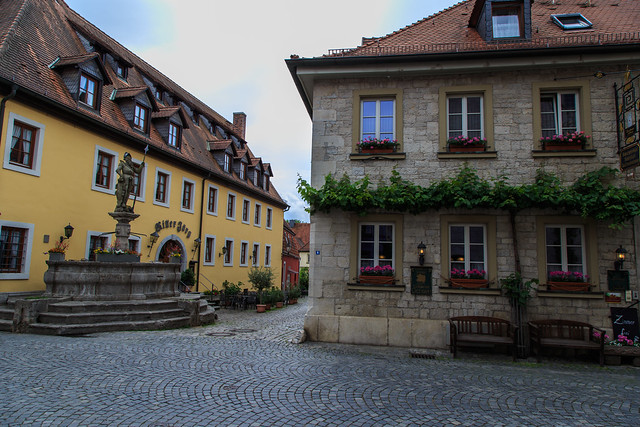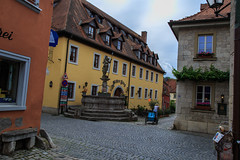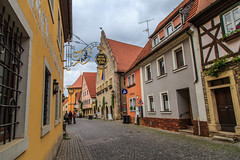Würzburg
Würzburg Hauptbahnhof is a railway station for the city of Würzburg in the German state of Bavaria. It was opened in 1864 to the north of the inner city as a replacement for the former Ludwigsbahnhof (Ludwig's station) in the city centre, the capacity of which had been exhausted by the dramatic increase of rail traffic. Even today, Würzburg station is one of the major stations in Bavaria, since it lies at the intersection of several heavily used rail corridors. In particular, the routes in the north–south direction from Hamburg and Bremen to Munich as well as in west–east direction from the Rhine-Ruhr and Rhine-Main to Nuremberg and Vienna. Apart from Aschaffenburg Hauptbahnhof, Würzburg is the only station in Lower Franconia to be served by Intercity-Express services. With its combination of rail, tram and bus services, the station is the main hub for public transport in the city and the district of Würzburg.
History
The city of Würzburg was the capital of the Grand Duchy of Würzburg under Ferdinand III until 1814. It was then part of the territories in Franconia that were granted to the Kingdom of Bavaria by the Congress of Vienna in compensation for the loss of the Tyrol and that part of Palatinate that was east of the Rhine to Baden. Because of its remoteness within Bavaria, Würzburg was not connected by the Ludwig South-North Railway, which crossed the entire kingdom. At the urging of the Bavarian parliament, the city was connected to the railway network by the second state railway, the Ludwig Western Railway only a few years later. Construction work began in 1852 and the 43 kilometre-long third stage from Schweinfurt to Würzburg (now part of the Bamberg–Rottendorf railway) of the 206 km-long line was opened on 1 June 1854. In the fourth and final stage, the line was opened to the Bavarian border in Kahl am Main via Gemünden am Main and Aschaffenburg on 1 October 1854 (now part of the Main–Spessart railway).
The first station of 1852: the Ludwig station
The first Würzburg station was named the Ludwigsbahnhof (Ludwig station) after King Ludwig I. At the request of the Ministry of War, the station was built inside the city walls, despite the higher land acquisition costs, at the exact location of the Mainfranken Theater today. This however meant, due to the already dense development, that it was possible to build only a terminal station. The area available for the station was about 400 metres long and between 50 and 100 metres wide and next to the station building and the train shed there was also a roundhouse and a carriage shed. It also included a workshop for the maintenance of rail vehicles and a freight warehouse. A second building was added, which was connected by tracks that had to be built on embankments that were up to five metres high due to the unevenness of the ground and as a result the building was higher than the surrounding streets.
It was designed in the Renaissance Revival style by the royal architect Gottfried von Neureuther, who designed many station buildings of the Royal Bavarian State Railways and described the Würzburg station as one of the most difficult buildings on the Ludwig Western Railway. The station building was a two-storey building, the front of which faced west to Theaterstraße, where a forecourt was designed as a formal entrance to the city. The slightly elevated ground floor, as a result of the high position of the tracks, was clad with limestone and sandstone and included, among other things, waiting rooms and a restaurant. A 100-metre-long and 24 metre-wide platform area adjoined the station building to the east. Under the 13 metre-high roof there were a track for passenger and freight trains and two bypass tracks. Large problems were experienced with the introduction of the tracks to the station area, as only two tracks ran through the city walls; these branched immediately after crossing the moat towards Schweinfurt and Gemünden. Sets of points had to be inserted on the bridge over the moat so that trains could be separated so that freight trains could run to the northern part of the station and passenger trains run to the southern part of the station. This limited the increase in capacity significantly, particularly for freight traffic.
Relocation of the station
In subsequent years the railways grew steadily. Although a lack of resources prevented rapid economic growth, as a result of the construction of new tracks, Würzburg became a railway junction. First, in 1861 construction started on a nearly 90 kilometre-long link between Würzburg and Ansbach station, where it connected with a line that had been built in 1859 by the town of Ansbach to connect with the Ludwig South-North Railway in Gunzenhausen. This line (which is now part of the Treuchtlingen–Würzburg railway) was completed in 1864, giving Würzburg a shorter connection to the major cities of Augsburg and Munich. Just a year later, a direct link was opened between Rottendorf and Fürth (now part of the Nuremberg–Würzburg railway), creating a much shorter than the line via Bamberg and relegating the Ludwig Western Railway to a minor role. At the same time the common section with the old route to Bamberg between Würzburg and Rottendorf was duplicated. In 1866, the Baden Odenwald Railway (Odenwaldbahn) was completed. It was last railway opened to Würzburg until the late 20th century. It was built mainly at the request of Bavaria, to connect the then Bavarian Rhenish Palatinate to its own railway network and ran from Würzburg via Osterburken and Mosbach to Heidelberg.
The new station outside the inner city
The terminus could no longer absorb the traffic of the additional lines. An extension of the facilities that were tight from the start was not possible due to the density of buildings in the inner city. To provide greater capacity for passenger services, it was planned initially to shift freight and shunting to a separate location. Against the backdrop of the ever-growing rail traffic and given the operational benefits of a through station, the decision was taken in 1862 to build a new station to the north of the city beneath the Schalksberg (hill) and near the famous Würzburger Stein vineyard. At this time the area was only sparsely populated and there was enough space available for a large station yard and a through station. The construction of the station was accompanied by an extensive reorganisation of the road network. The mainly narrow and winding streets of the town centre were greatly improved by the widening of existing streets and the building of the central Schönbornstraße. The newly created Kaiserstraße connected the outlying station complex and the town. A new district was then established in the immediate vicinity of the station and in place of the former city wall a ring of parks in the English style was created. Julius-Maximilian's University and imposing Gründerzeit villas were built between the station and the banks of the Main river. In addition, a separate district for railway employees was built to the northeast of the station.
The architect Friedrich Bürklein was commissioned for the construction of the station building. He had been responsible for the construction of München Hauptbahnhof and the stations in Augsburg, Bamberg, Nördlingen, Nuremberg and Bad Kissingen. Construction started in 1863 and it was completed in 1869.
The station building was an imposing building, which consisted of a two-story central hall, which was bounded by two raised side wings. On the ground floor the entire front of the central hall was composed of arcade-like archways, which gave access to the inside of the station. There were, in addition to a salon for the king, the usual facilities of a station at the time, such as waiting rooms for four classes, two restaurants, ticketing and baggage counter and several administrative offices. The rooms on the upper floor were used as apartments for the staff. The platforms were one level above the street level as they were built on an embankment. Therefore, in the middle of the entrance building, there was a staircase to the concourse supported by 14 marble columns.
The railway tracks were built over a very large area. Sidings, locomotive and carriage maintenance shops and warehouses were built to the north of the platform area. To the east there were the facilities of the Grand Duchy of Baden State Railway, which operated the Odenwald Railway towards Heidelberg, as it ran through Bavaria for only about 20 kilometres.
Destruction during World War II and reconstruction
Until shortly before the end of the Second World War people still living in Würzburg had the illusion that the city would be spared an air raid because no significant industry was located in the city and it had three hospitals. However, Würzburg had great importance for rail transport, the logistical backbone of German armaments. On 23 February 1945, during an air strike of the United States Army Air Force, which was actually directed at Bayreuth, a large part of the station area was destroyed or severely degraded by about 200 bombs. Although the only threat from Würzburg for the Allies had been eliminated and another attack seemed unlikely, starting on the evening of 16 March 1945 in England, about 230 four-engined Avro Lancaster bombers of the Royal Air Force flew to Würzburg. In this destruction, considered one of the most devastating in the war, about 5,000 people lost their lives. In addition, 90 percent of the buildings in the inner city were damaged, which made Würzburg one of the most devastated cities of World War II. The city, which had often been called the "pearl of the baroque", was reduced to a pile of rubble within 19 minutes. Following the destruction on 23 February of the station built by Friedrich Bürklein, the station building of the Ludwig station was now also destroyed; since the closing of railway operations it had been used as a school.
The ruins of the Ludwig station were completely r…
Looking for places related to Würzburg?
Those are other destinations to find places related to Würzburg:










